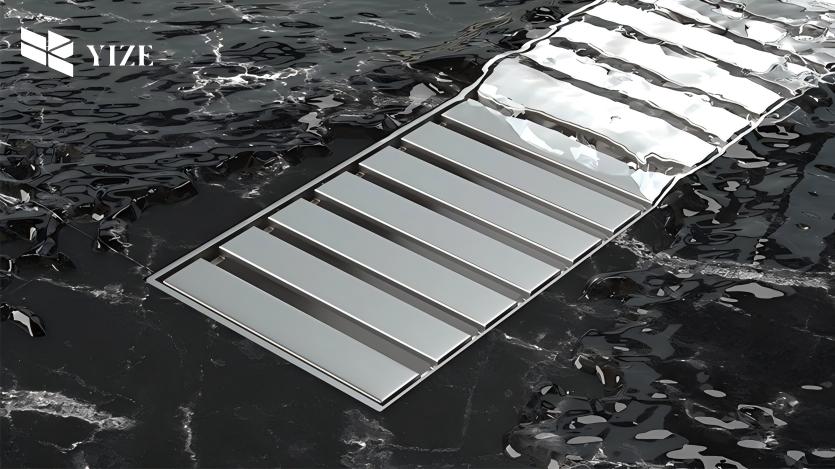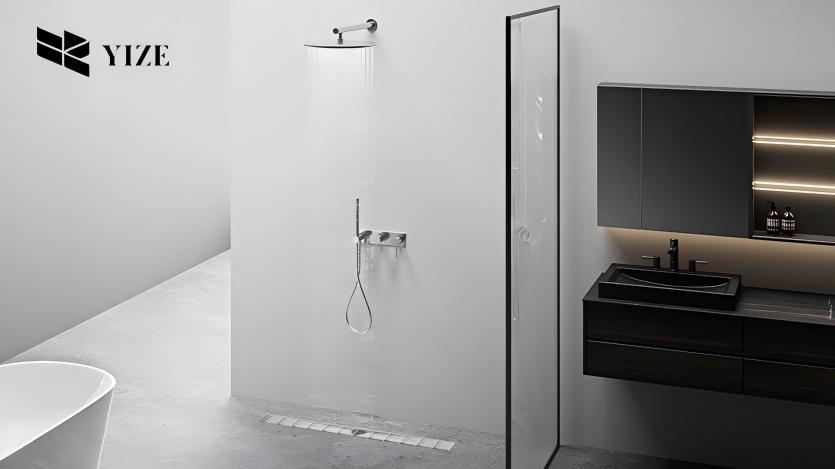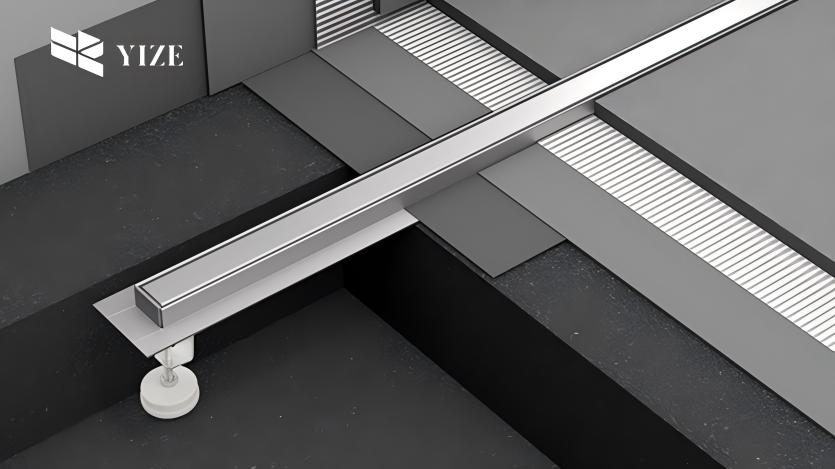
Ever watched water pool around your feet during a shower? You’re not alone. 73% of bathroom renovations fail because someone picked the wrong drain capacity. The math isn’t rocket science—but one calculation error floods your bathroom faster than you can say “plumber.”
This guide breaks down drainage capacity into bite-sized pieces. No engineering degree required.
What you’ll learn:
- Quick formulas to calculate your exact drainage needs
- How shower head flow rates impact drain selection
- Real capacity requirements for different bathroom sizes
- When to size up (and when you’re overspending)
We’ve helped contractors and homeowners nail drainage calculations for over a decade.YZDRAIN’s engineering team has seen every overflow scenario imaginable—from luxury rain showers to compact apartment bathrooms.
I. Quick Formulas to Calculate Your Exact Drainage Needs
Drainage capacity boils down to one simple principle: your drain must handle more water than your shower head delivers. Miss this, and you’re literally standing in your mistake.
The golden formula? Drain Capacity = Shower Flow Rate × 1.5
That 1.5 multiplier? It’s your safety buffer. Think of it as insurance against hair, soap scum, and that one time you forget to clean the drain for three months.
1. The Basic Math That Saves Bathrooms
Here’s what you actually need to calculate:
Step 1: Find Your Shower Head’s Flow Rate
- Standard shower heads: 2.5 GPM (gallons per minute)
- Low-flow models: 1.5-2.0 GPM
- Rain shower heads: 2.5-6.0 GPM
- Multiple heads? Add them all together
Step 2: Apply the Safety Factor
- Single shower head: Flow rate × 1.5
- Multiple heads/body sprays: Flow rate × 2.0
- Curbless showers: Flow rate × 2.5
Step 3: Convert to Drainage Units (DFU)
One DFU = 7.5 GPM. Most building codes speak in DFUs, so here’s your translation:
- 2″ drain = 6 DFU (45 GPM)
- 3″ drain = 20 DFU (150 GPM)
- 4″ drain = 35 DFU (262 GPM)
2. Real-World Example Time
You’ve got a rain shower head (4.0 GPM) plus two body sprays (2.5 GPM each). Total flow? 9.0 GPM.
Apply the multiple-head factor: 9.0 × 2.0 = 18 GPM minimum drainage needed.
A standard 2″ drain handles 45 GPM. You’re golden. But drop down to a 1.5″ drain (which only handles 21 GPM), and you’re cutting it dangerously close.
3. The Slope Factor Nobody Talks About
Your drain capacity means nothing without a proper slope. EvenYZDRAIN’s highest-capacity horizontal outlets need that magic 2% grade (1/4 inch per foot). Less slope = slower drainage = standing water, regardless of your drain size.
Pro tip: Double-check your contractor’s slope work. We’ve seen perfect drains fail because someone eyeballed the gradient.
II. How Shower Head Flow Rates Impact Drain Selection

Modern shower heads range from water-sipping 1.5 GPM models to luxury systems pushing 10+ GPM. Each type demands different drainage strategies.
1. Flow Rate Reality Check
Low-Flow Heads (1.5-2.0 GPM)
Standard 2″ drains handle these with room to spare. You could run three simultaneously without breaking a sweat. Perfect for:
- Guest bathrooms
- Powder room conversions
- Water-conscious renovations
Standard Heads (2.5 GPM)
The sweet spot. Most drains are designed around this flow rate. But here’s the kicker—combine two standard heads, and you’re already at 5 GPM. That safety buffer starts looking pretty smart now.
Rain Shower Heads (3.0-6.0 GPM)
Where drainage gets serious. A single 12″ rain head can dump 4.5 GPM. Add body sprays? You’re pushing 8-10 GPM easy. These setups need:
- Minimum 3″ drain lines
- Strategic drain placement
- Often multiple drain points
Luxury Multi-Head Systems (8.0+ GPM)
We’re talking full spa experiences here. Multiple rain heads, body jets, handheld wands—the works. These systems can hit 15-20 GPM without breaking a sweat.
2. The Compound Effect
Here’s what catches people off guard: flow rates stack exponentially, not linearly.
One 2.5 GPM head? Any drain works. Two heads? Now you need 5 GPM capacity plus buffer. Add body sprays? Suddenly, you’re at 10 GPM, and that standard drain looks inadequate.
3. Matching Drains to Flow Rates
| Shower Setup | Total GPM | Minimum Drain Size | YZDRAIN Solution |
| Single standard head | 2.5 | 2″ | Any standard model |
| Dual heads | 5.0 | 2″ | Horizontal-outlet series |
| Rain + handheld | 6.5 | 3″ | 360° rotatable outlet |
| Full spa system | 12+ | 4″ or dual 3″ | Custom dual-drain setup |
4. The Pressure Variable
Water pressure affects everything. High pressure (80+ PSI) can push flow rates 20-30% above manufacturer specs. That “2.5 GPM” head might actually deliver 3.2 GPM.
Test your actual flow rate:
- Run shower full blast for 10 seconds into a bucket
- Measure the water
- Multiply by 6 for your true GPM
YZDRAIN’s vertical-outlet drainsinclude pressure-compensating features that maintain consistent drainage even when your water pressure spikes. The high-density ABS flanges won’t crack under pressure variations either—something we learned after testing 10,000+ installations across different pressure zones.
III. Real Capacity Requirements for Different Bathroom Sizes
Bathroom size dictates more than tile choices. Smaller spaces flood faster—there’s less room for error when water has nowhere to go.
1. Size-Specific Requirements
Compact Bathrooms (Under 40 sq ft)
- Standard drain capacity: 45-60 GPM
- Maximum safe shower flow: 4 GPM
- Best drain type: Single 2″ center drain
These tight spaces can’t handle pooling. Even an extra 0.5 GPM overwhelms the floor area. Stick to single shower heads here.
Standard Bathrooms (40-75 sq ft)
- Recommended capacity: 60-90 GPM
- Safe shower flow: Up to 7.5 GPM
- Options: 3″ drain or dual 2″ configuration
Most homes fall here. You’ve got flexibility for a rain head or body sprays—not both, without drainage upgrades.
Master Bathrooms (75-150 sq ft)
- Capacity needs: 90-150 GPM
- Shower flow range: 8-15 GPM
- Setup: Linear drains or multiple point drains
Larger floors = more water tolerance. But don’t get cocky. We’ve seen 200 sq ft bathrooms flood from poor drain placement.
Luxury/Spa Bathrooms (150+ sq ft)
- Minimum capacity: 150+ GPM
- Multi-head systems: 15-25 GPM
- Solution: Custom drainage networks
2. The Distance Factor
Water travels slowly on flat surfaces. Every foot between the shower head and the drain adds lag time. In a 10×10 bathroom, corner-to-corner drainage takes 40% longer than centered drainage.
YZDRAIN’s 360° rotatable outlets solve this by letting you position drainage exactly where water naturally flows—typically 18-24″ from the primary shower head.
IV. When to Size Up (and When You’re Overspending)

Bigger isn’t always better. Oversized drains cost more and complicate installation without adding value. Here’s your sizing reality check.
1. Size Up When:
- Multiple Water Sources Converge: Rain head + handheld + body sprays = size up. Each source compounds drainage needs exponentially.
- Curbless Designs: No barrier means water spreads everywhere. Add 50% to your calculated capacity for curbless showers.
- Future-Proofing Renovations: Planning to upgrade from standard to rain shower later? Install the bigger drain now. Retrofitting drains costs 3x more than initial installation.
- Clay or Slow-Draining Soil: Your drain connects to pipes in the ground. Clay soil reduces overall system drainage by 30%. Size up accordingly.
2. You’re Overspending When:
- Single Standard Shower Head: A 4″ drain for one 2.5 GPM head? You’re burning money. Standard 2″ drains handle this perfectly.
- Guest Bathroom Overkill. That powder room conversion doesn’t need commercial-grade drainage. Save the budget for where it counts.
- Matching Aesthetics Over Function: Choosing a 48″ linear drain for a 36″ shower? The extra length adds zero drainage benefit—just cost.
3. The Sweet Spot Formula
Optimal sizing = Flow rate × 1.5 (rounded up to the next standard size)
A 6 GPM shower system needs 9 GPM capacity. The next standard size up? A 3″ drain at 150 GPM. Yes, it seems like overkill, but standard sizes jump dramatically. There’s no 2.5″ drain option.
Pro tip: YZDRAIN’s horizontal-outlet drains maximize capacity within standard sizes. Our 2″ models outperform generic 2″ drains by 20% through optimized outlet geometry. Sometimes the right product means you don’t need to size up at all.
4. Ready to Get Your Drainage Math Right With YZDRAIN?
Water pooling during showers isn’t inevitable—it’s preventable math. Calculate your flow rate, add the safety buffer, and match your drain accordingly. Most drainage disasters happen when someone skips these basics.
Key takeaways:
- Always multiply the shower flow rate by 1.5 for the minimum drain capacity
- Multiple shower heads need a 2x safety factor, not 1.5x
- Bathroom size affects drainage speed—smaller spaces flood faster
- Proper slope (2% grade) matters as much as drain size
- Size up for curbless showers, multi-head systems, and clay soil
- Don’t overspend on drains for single standard shower heads
YZDRAIN’s engineering team has analyzed thousands of bathroom installations to perfect our drainage solutions. Our drains don’t just meet calculated capacities—they exceed them through optimized outlet designs and precision manufacturing. Whether you need our horizontal-outlet series for tight spaces or 360° rotatable models for perfect positioning, we’ve engineered products that keep your feet dry.
FAQs
Q1: How to calculate the drain capacity?
Drain capacity = pipe diameter converted to GPM. A 2″ drain handles 45 GPM, 3″ handles 150 GPM, and 4″ handles 262 GPM. Check manufacturer specs for exact ratings—quality drains like YZDRAIN’s often exceed standard capacities.
Q2: How to calculate the drainage needed?
Drainage needed = Total shower flow rate × safety factor. Single heads use 1.5x factor, multiple heads need 2x. A 4 GPM rain shower needs 6 GPM drainage minimum (4 × 1.5 = 6).
Q3: What is the formula for drainage?
The core formula: Drain Size (GPM) ≥ Shower Flow (GPM) × Safety Factor. For building codes using DFUs: 1 DFU = 7.5 GPM. Your drain’s DFU rating must exceed your fixture’s DFU demand.
Q4: How to calculate drainage intensity?
Drainage intensity = flow rate ÷ drain area. A 3″ round drain (7 sq in) handling 150 GPM processes 21.4 GPM per square inch. Linear drains spread this intensity across length, reducing strain on any single point.

